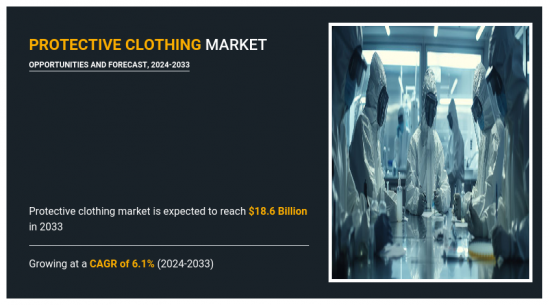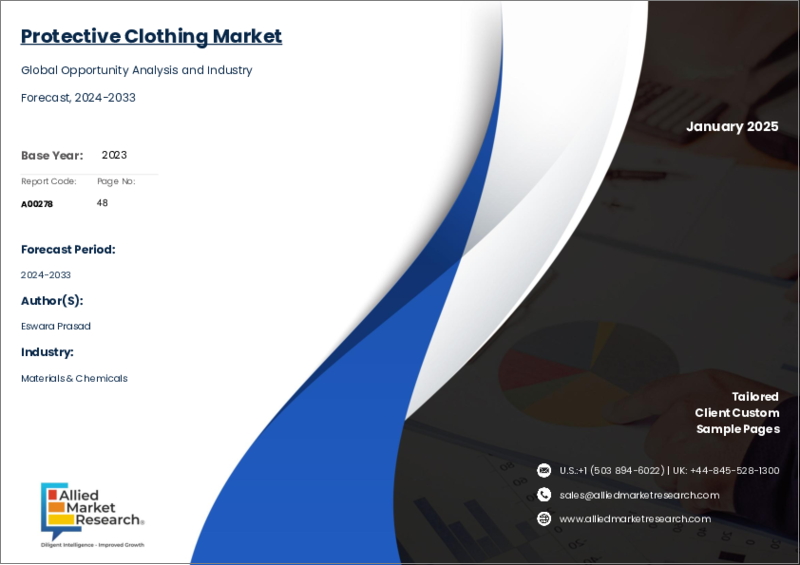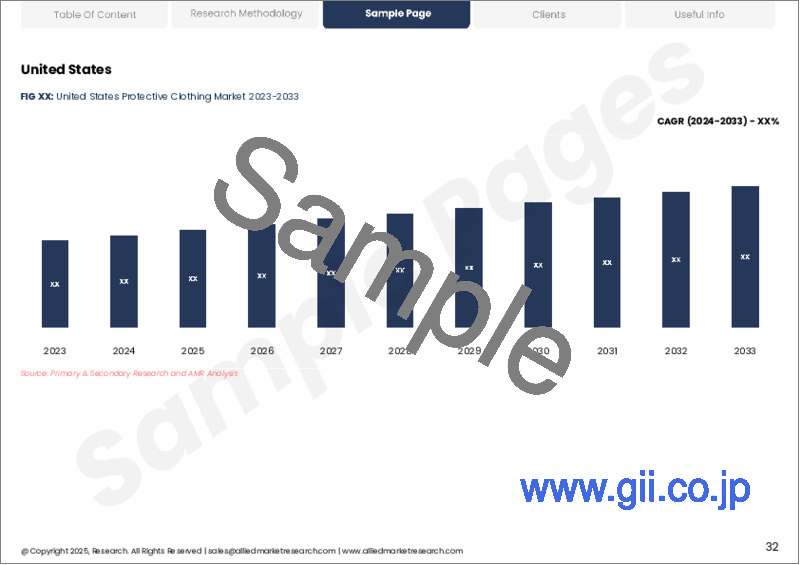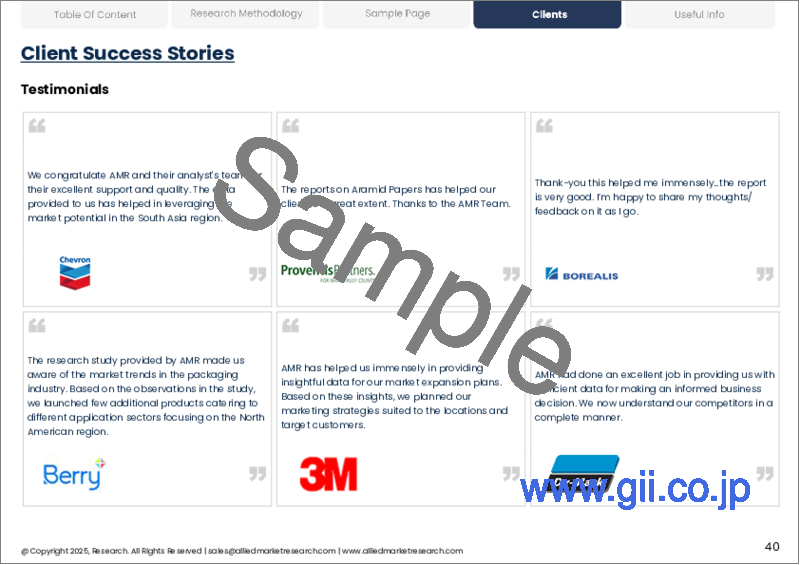|
|
市場調査レポート
商品コード
1645702
防護服の世界市場:材料タイプ別、用途別、最終用途産業別 - 機会分析と産業予測、2024年~2033年Protective Clothing Market By Material Type (Aramid and Blends, Polyolefin and Blends, Polybenzimidaloe, Cotton Fibers, Laminated Polyesters, Others), By Application, By End Use Industry : Global Opportunity Analysis and Industry Forecast, 2024-2033 |
||||||
|
|||||||
| 防護服の世界市場:材料タイプ別、用途別、最終用途産業別 - 機会分析と産業予測、2024年~2033年 |
|
出版日: 2024年11月01日
発行: Allied Market Research
ページ情報: 英文 300 Pages
納期: 2~3営業日
|
- 全表示
- 概要
- 目次
世界の防護服市場は、2023年には103億米ドルとなり、2024年から2033年までのCAGRは6.1%で成長し、2033年までには186億米ドルに達すると予測されています。

イントロダクション
防護服とは、様々な作業環境、産業、日常活動でしばしば発生する潜在的な危険から個人を保護するために設計された衣服、付属品、装備を指します。これらの防護服は、化学物質への暴露、生物学的脅威、極端な温度、放射線、火災、電気的危険などの外的要因による傷害のリスクを最小限に抑えるように設計されています。防護服は労働者や個人を保護し、安全性、快適性、そして危害のリスクが高まる環境での全体的な幸福を確保する上で重要な役割を果たしています。
ヘルスケア環境では、防護服は感染症、体液、その他の危険物から労働者を守るために極めて重要です。医師、看護師、検査技師、病院スタッフなどの医療従事者は、病原体への汚染や暴露のリスクを軽減するため、個人用保護具(PPE)を着用する必要があります。この分野の防護服の主な例としては、手術衣、手袋、マスク、フェイスシールド、エプロンなどがあります。これらの衣服は感染性物質に対するバリアを提供し、特に手術室、集中治療室(ICU)、検査室などのリスクの高い環境において、病気の蔓延を防ぐのに不可欠です。
市場力学
職場の安全規制に対する需要の増加が防護服市場の成長を促進すると予想されます。特に建設、石油・ガス、製造業などの高リスク産業における職場安全規制の急増が、防護服の需要を促進しています。例えば、建設業や製造業では、より厳しい安全規制の導入により、ハードハット、手袋、高視認性ベスト、難燃性衣服などの保護具が必須となっています。米国のOSHAや欧州のCEなどの規制機関は、さまざまな作業環境で使用しなければならない防具のタイプと品質について、厳しいガイドラインを課しています。これらの規制は、落下、機器の故障、化学物質への暴露、その他の職場の危険に関連する負傷を最小限に抑えることを目的としています。2023年12月、OSHAは現行の個人用保護具(PPE)基準の更新を目的とした新たな規制案を発表し、何が適切な安全装備であるかをより明確にしました。この提案には、PPEが労働者に適切にフィットしていることを雇用主が確認するための要件が含まれるとともに、コミュニティ製品や「フリーサイズ」製品の使用も禁止されています。不適合または標準以下のPPEは、労働者に重傷を負わせたり、場合によっては死亡させたりするリスクを大幅に高めます。その結果、OSHAの新規制は、雇用主がすべての労働者に適合した安全なPPEを提供することを保証しなければならないことを強調しています。
しかし、新興国市場での認識が限定的であることが、予測期間中の防護服市場の成長を抑制すると予想されます。多くの開発途上地域では、防護服の重要性に関する認識が依然として限定的であるため、様々な産業での採用が妨げられています。アフリカ、東南アジア、ラテンアメリカの一部のような地域の国々は、潜在的な危険から労働者を守るために個人用保護具(PPE)が果たす重要な役割について、広く理解を得る上で課題に直面することが多いです。この認識不足は、建設、製造、農業、さらにはヘルスケアなど、労働者が怪我や有害な環境要因にさらされるリスクが高い分野で特に顕著です。
セグメントの概要
防護服市場は、材料タイプ、用途、最終用途産業、地域に区分されます。材料タイプ別では、市場はアラミド・ブレンド、ポリオレフィン・ブレンド、ポリベンズイミダロエ(PBI)、綿繊維、ラミネートポリエステル、その他に分別されます。用途別では、熱、機械、化学、生物・放射線、その他に分けられます。最終用途産業別では、石油・ガス、建設・製造、医薬・医療、軍事・防衛、消防、その他に分類されます。地域別では、市場は北米、欧州、アジア太平洋、ラテンアメリカ、中東・アフリカで分析されます。
材料タイプ別では、ポリベンゾイミダゾール(PBI)が予測期間中のCAGR7.1%で最も急成長しています。ポリベンゾイミダゾール(PBI)は、優れた耐熱性と耐薬品性で知られる高性能ポリマーであり、特に労働者が過酷な条件にさらされる産業や環境において、防護服の理想的な材料となっています。PBIは優れた耐薬品性を備えているため、作業員が危険な化学薬品や酸、溶剤にさらされる可能性のある産業で重宝されています。この生地は劣化しにくく、こうした厳しい環境でも保護品質を維持するため、有害物質への暴露による怪我や長期的な健康問題の防止に役立ちます。
最終用途産業別では、消防が2023年に市場で最も急成長するセグメントであり、予測期間中のCAGRは7.2%です。防護服は消防において重要な役割を果たし、危険な環境に対処する際に消防士の安全と健康を確保します。消防用防護服の主な機能は、消防士を極端な温度、炎、および緊急対応中に遭遇する可能性のあるその他の物理的危険から保護することです。これらの衣服は、必要な快適性、柔軟性、耐久性を提供しながら、火災によって生成される強烈な熱に耐えるように設計されています。消防用防護服の主な構成要素には、出動用コート、ズボン、ヘルメット、手袋、ブーツなどがあります。出動用コートやズボンは通常、ノーメックス(Nomex)、ケブラー(Kevlar)、PBI(ポリベンゾイミダゾール)などの多層材料で作られており、熱や炎に対する高い耐性を備えています。これらの材料はまた、化学的危険、湿気、電気的リスクからの保護も提供します。
競合分析
利害関係者にとっての主なメリット
- 当レポートでは、2023年から2033年にかけての防護服市場分析の市場セグメント、現在の動向、推定・動向分析、力学を定量的に分析し、有力な防護服市場機会を特定します。
- 市場促進要因、市場抑制要因、市場機会に関連する情報とともに市場調査を提供します。
- ポーターのファイブフォース分析では、利害関係者が利益重視のビジネス決定を下し、サプライヤーとバイヤーのネットワークを強化できるように、バイヤーとサプライヤーの潜在力を強調します。
- 防護服市場のセグメンテーションの詳細な分析は、市場機会を決定するのに役立ちます。
- 各地域の主要国は、世界市場への収益貢献度に応じてマッピングされています。
- 市場企業のポジショニングはベンチマーキングを容易にし、市場企業の現在のポジションを明確に理解することができます。
- 本レポートには、地域および世界の防護服市場動向、主要企業、市場セグメント、応用分野、市場成長戦略の分析が含まれています。
本レポートで可能なカスタマイズ(追加費用とスケジュールがあります。)
- 消費者の購買行動分析
- 製品ライフサイクル
- 新規参入企業:地域別
- 技術動向分析
- 製品/セグメント別企業の市場セグメンテーション分析
- 主な企業の新製品開発/製品マトリックス
- 国、地域、世界レベルでの患者/疫学データ
- 規制ガイドライン
- クライアントの関心に特化した追加企業プロファイル
- 企業プロファイルの拡張リスト
- 過去の市場データ
- 主要企業の詳細(所在地、連絡先、サプライヤー/ベンダーネットワークなどを含む、エクセル形式)
- 顧客/消費者/原料サプライヤーのリスト-バリューチェーン分析
- 世界/地域/国別レベルでのプレーヤーの市場シェア分析
- SWOT分析
目次
第1章 イントロダクション
第2章 エグゼクティブサマリー
第3章 市場概要
- 市場の定義と範囲
- 主要な調査結果
- 主要な影響要因
- 主要な投資機会
- ポーターのファイブフォース分析
- 市場力学
- 促進要因
- 抑制要因
- 機会
- バリューチェーン分析
- 規制ガイドライン
第4章 防護服市場:材料タイプ別
- 概要
- アラミド・ブレンド
- ポリオレフィン・そのブレンド
- ポリベンズイミダロエ(PBI)
- 綿繊維
- ラミネートポリエステル
- その他
第5章 防護服市場:用途別
- 概要
- 熱
- 機械
- 化学
- 生物/放射線
- その他
第6章 防護服市場:最終用途産業別
- 概要
- 石油・ガス
- 建設・製造
- 製薬・医療
- 軍事・防衛
- 消防
- その他
第7章 防護服市場:地域別
- 概要
- 北米
- 米国
- カナダ
- メキシコ
- 欧州
- ドイツ
- フランス
- 英国
- スペイン
- イタリア
- その他
- アジア太平洋
- 中国
- インド
- 日本
- 韓国
- オーストラリア
- その他
- ラテンアメリカ、中東・アフリカ
- ブラジル
- 南アフリカ
- サウジアラビア
- その他
第8章 競争情勢
- イントロダクション
- 主要成功戦略
- 主要10社の製品マッピング
- 競合ダッシュボード
- 競合ヒートマップ
- 主要企業のポジショニング、2023年
第9章 企業プロファイル
- VF Corporation
- TEIJIN LIMITED.
- 3M
- DuPont
- Glen Raven, Inc.
- Ballyclare International
- TenCate Protective Fabrics
- Lakeland Inc.
- ANSELL LTD
- Honeywell International Inc.
The global protective clothing market was valued at $10.3 billion in 2023, and is projected to reach $18.6 billion by 2033, growing at a CAGR of 6.1% from 2024 to 2033.

Introduction
Protective clothing refers to garments, accessories, and equipment designed to shield individuals from potential hazards that often arise in various work environments, industries, or daily activities. These protective garments are engineered to minimize the risk of injury from external factors such as chemical exposure, biological threats, extreme temperatures, radiation, fire, and electrical hazards. Protective clothing plays a crucial role in safeguarding workers and individuals, ensuring their safety, comfort, and overall well-being in environments where the risk of harm is elevated.
In healthcare environments, protective clothing is crucial for safeguarding workers from infectious diseases, bodily fluids, and other hazardous materials. Medical professionals such as doctors, nurses, laboratory technicians, and hospital staff must wear personal protective equipment (PPE) to reduce the risk of contamination and exposure to pathogens. Key examples of protective clothing in this field include surgical gowns, gloves, masks, face shields, and aprons. These garments provide a barrier against infectious agents and are vital in preventing the spread of diseases, especially in high-risk settings such as operating rooms, intensive care units (ICUs), and laboratories.
Market Dynamics
Increase in demand for workplace safety regulations is expected to drive the growth of protective clothing market. Surge in workplace safety regulations, particularly in high-risk industries such as construction, oil & gas, and manufacturing, drives the demand for protective clothing. In the construction and manufacturing sectors, for example, the introduction of stricter safety regulations has made protective gear, such as hard hats, gloves, high-visibility vests, and flame-resistant clothing, mandatory. Regulatory bodies such as OSHA in the U.S. and CE in Europe impose stringent guidelines on the type and quality of protective gear that must be used in various work environments. These regulations aim to minimize injuries related to falls, equipment malfunctions, chemical exposures, and other workplace hazards. In December 2023, OSHA unveiled new proposed regulations aimed at updating current Personal Protective Equipment (PPE) standards, offering more clarity on what constitutes suitable safety gear. This proposal includes a requirement for employers to ensure that PPE fits workers properly, while also prohibiting the use of community or "one-size-fits-all" products. Ill-fitting or substandard PPE significantly increases the risk of severe or even fatal injuries to workers. As a result, OSHA's new regulations emphasize that employers must guarantee that all workers are provided with well-fitted and safe PPE.
However, limited awareness in developing regions is expected to restrain the growth of protective clothing market during the forecast period. In many developing regions, the awareness regarding the importance of protective clothing remains limited, hindering its adoption in various industries. Countries in regions such as Africa, Southeast Asia, and parts of Latin America often face challenges in creating widespread understanding about the critical role that personal protective equipment (PPE) plays in safeguarding workers from potential hazards. This lack of awareness is particularly evident in sectors such as construction, manufacturing, agriculture, and even healthcare, where workers are at heightened risk of exposure to injuries and harmful environmental factors.
Segments Overview
The protective clothing market is segmented into material type, application, end-use industry, and region. By material type, the market is segregated into aramid & blends, polyolefin & blends, polybenzimidaloe (PBI), cotton fiber, laminated polyesters, and others. By application, the market is divided into thermal, mechanical, chemical, biological/radiation, and others. By end-use industry, the market is classified into oil & gas, construction & manufacturing, pharmaceuticals/medical, military & defense, firefighting, and others. Region-wise, the market is analyzed across North America, Europe, Asia-Pacific, and LAMEA.
On the basis of material type, polybenzimidaloe (PBI) is the fastest growing segment in the market representing the CAGR of 7.1% during the forecast period. Polybenzimidazole (PBI) is a high-performance polymer known for its excellent thermal and chemical resistance properties, making it an ideal material for protective clothing, especially in industries and environments where workers are exposed to extreme conditions. PBI offers excellent chemical resistance, making it valuable in industries where workers might be exposed to hazardous chemicals, acids, or solvents. The fabric resists degradation and maintains its protective qualities in these challenging environments, helping prevent injuries and long-term health issues from exposure to harmful substances.
On the basis of end-use industry, firefighting is the fastest growing segment in the market in 2023 representing the CAGR of 7.2% during the forecast period. Protective clothing plays a crucial role in firefighting, ensuring the safety and well-being of firefighters when dealing with hazardous environments. The primary function of firefighting protective clothing is to shield firefighters from extreme temperatures, flames, and other physical dangers they may encounter during emergency responses. These garments are designed to withstand the intense heat produced by fires while offering necessary comfort, flexibility, and durability. The key components of firefighting protective clothing include turnout coats, pants, helmets, gloves, and boots. Turnout coats and pants are typically made from multi-layered materials like Nomex, Kevlar, or PBI (polybenzimidazole), which provide high resistance to heat and flame. These materials also offer protection against chemical hazards, moisture, and electrical risks.
Competitive Analysis
In addition, the report covers the profiles of key industry participants such as VF Corporation, TEIJIN LIMITED, 3M, DuPont, Glen Raven, Inc., Ballyclare International, TenCate Protective Fabrics, Lakeland Inc, ANSELL LTD, and Honeywell International Inc.
Key Benefits For Stakeholders
- This report provides a quantitative analysis of the market segments, current trends, estimations, and dynamics of the protective clothing market analysis from 2023 to 2033 to identify the prevailing protective clothing market opportunities.
- The market research is offered along with information related to key drivers, restraints, and opportunities.
- Porter's five forces analysis highlights the potency of buyers and suppliers to enable stakeholders make profit-oriented business decisions and strengthen their supplier-buyer network.
- In-depth analysis of the protective clothing market segmentation assists to determine the prevailing market opportunities.
- Major countries in each region are mapped according to their revenue contribution to the global market.
- Market player positioning facilitates benchmarking and provides a clear understanding of the present position of the market players.
- The report includes the analysis of the regional as well as global protective clothing market trends, key players, market segments, application areas, and market growth strategies.
Additional benefits you will get with this purchase are:
- Quarterly Update and* (only available with a corporate license, on listed price)
- 5 additional Company Profile of client Choice pre- or Post-purchase, as a free update.
- Free Upcoming Version on the Purchase of Five and Enterprise User License.
- 16 analyst hours of support* (post-purchase, if you find additional data requirements upon review of the report, you may receive support amounting to 16 analyst hours to solve questions, and post-sale queries)
- 15% Free Customization* (in case the scope or segment of the report does not match your requirements, 15% is equivalent to 3 working days of free work, applicable once)
- Free data Pack on the Five and Enterprise User License. (Excel version of the report)
- Free Updated report if the report is 6-12 months old or older.
- 24-hour priority response*
- Free Industry updates and white papers.
Possible Customization with this report (with additional cost and timeline, please talk to the sales executive to know more)
- Consumer Buying Behavior Analysis
- Product Life Cycles
- Upcoming/New Entrant by Regions
- Technology Trend Analysis
- Market share analysis of players by products/segments
- New Product Development/ Product Matrix of Key Players
- Patient/epidemiology data at country, region, global level
- Regulatory Guidelines
- Additional company profiles with specific to client's interest
- Expanded list for Company Profiles
- Historic market data
- Key player details (including location, contact details, supplier/vendor network etc. in excel format)
- List of customers/consumers/raw material suppliers- value chain analysis
- Market share analysis of players at global/region/country level
- SWOT Analysis
Key Market Segments
By Material Type
- Others
- Aramid and Blends
- Polyolefin and Blends
- Polybenzimidaloe (PBI)
- Cotton Fibers
- Laminated Polyesters
By Application
- Thermal
- Mechanical
- Chemical
- Biological/Radiation
- Others
By End Use Industry
- Oil and Gas
- Construction and Manufacturing
- Pharmaceuticals/Medical
- Military and Defense
- Firefighting
- Others
By Region
- North America
- U.S.
- Canada
- Mexico
- Europe
- Germany
- France
- UK
- Spain
- Italy
- Rest of Europe
- Asia-Pacific
- China
- India
- Japan
- South Korea
- Australia
- Rest of Asia-Pacific
- LAMEA
- Brazil
- South Africa
- Saudi Arabia
- Rest of LAMEA
Key Market Players:
- 3M
- ANSELL LTD
- Ballyclare International
- DuPont
- Glen Raven, Inc.
- Honeywell International Inc.
- Lakeland Inc.
- TEIJIN LIMITED.
- TenCate Protective Fabrics
- VF Corporation
TABLE OF CONTENTS
CHAPTER 1: INTRODUCTION
- 1.1. Report description
- 1.2. Key market segments
- 1.3. Key benefits to the stakeholders
- 1.4. Research methodology
- 1.4.1. Primary research
- 1.4.2. Secondary research
- 1.4.3. Analyst tools and models
CHAPTER 2: EXECUTIVE SUMMARY
- 2.1. CXO perspective
CHAPTER 3: MARKET OVERVIEW
- 3.1. Market definition and scope
- 3.2. Key findings
- 3.2.1. Top impacting factors
- 3.2.2. Top investment pockets
- 3.3. Porter's five forces analysis
- 3.4. Market dynamics
- 3.4.1. Drivers
- 3.4.2. Restraints
- 3.4.3. Opportunities
- 3.5. Value Chain Analysis
- 3.6. Regulatory Guidelines
CHAPTER 4: PROTECTIVE CLOTHING MARKET, BY MATERIAL TYPE
- 4.1. Overview
- 4.1.1. Market size and forecast
- 4.2. Aramid and Blends
- 4.2.1. Key market trends, growth factors and opportunities
- 4.2.2. Market size and forecast, by region
- 4.2.3. Market share analysis by country
- 4.3. Polyolefin and Blends
- 4.3.1. Key market trends, growth factors and opportunities
- 4.3.2. Market size and forecast, by region
- 4.3.3. Market share analysis by country
- 4.4. Polybenzimidaloe (PBI)
- 4.4.1. Key market trends, growth factors and opportunities
- 4.4.2. Market size and forecast, by region
- 4.4.3. Market share analysis by country
- 4.5. Cotton Fibers
- 4.5.1. Key market trends, growth factors and opportunities
- 4.5.2. Market size and forecast, by region
- 4.5.3. Market share analysis by country
- 4.6. Laminated Polyesters
- 4.6.1. Key market trends, growth factors and opportunities
- 4.6.2. Market size and forecast, by region
- 4.6.3. Market share analysis by country
- 4.7. Others
- 4.7.1. Key market trends, growth factors and opportunities
- 4.7.2. Market size and forecast, by region
- 4.7.3. Market share analysis by country
CHAPTER 5: PROTECTIVE CLOTHING MARKET, BY APPLICATION
- 5.1. Overview
- 5.1.1. Market size and forecast
- 5.2. Thermal
- 5.2.1. Key market trends, growth factors and opportunities
- 5.2.2. Market size and forecast, by region
- 5.2.3. Market share analysis by country
- 5.3. Mechanical
- 5.3.1. Key market trends, growth factors and opportunities
- 5.3.2. Market size and forecast, by region
- 5.3.3. Market share analysis by country
- 5.4. Chemical
- 5.4.1. Key market trends, growth factors and opportunities
- 5.4.2. Market size and forecast, by region
- 5.4.3. Market share analysis by country
- 5.5. Biological/Radiation
- 5.5.1. Key market trends, growth factors and opportunities
- 5.5.2. Market size and forecast, by region
- 5.5.3. Market share analysis by country
- 5.6. Others
- 5.6.1. Key market trends, growth factors and opportunities
- 5.6.2. Market size and forecast, by region
- 5.6.3. Market share analysis by country
CHAPTER 6: PROTECTIVE CLOTHING MARKET, BY END USE INDUSTRY
- 6.1. Overview
- 6.1.1. Market size and forecast
- 6.2. Oil and Gas
- 6.2.1. Key market trends, growth factors and opportunities
- 6.2.2. Market size and forecast, by region
- 6.2.3. Market share analysis by country
- 6.3. Construction and Manufacturing
- 6.3.1. Key market trends, growth factors and opportunities
- 6.3.2. Market size and forecast, by region
- 6.3.3. Market share analysis by country
- 6.4. Pharmaceuticals/Medical
- 6.4.1. Key market trends, growth factors and opportunities
- 6.4.2. Market size and forecast, by region
- 6.4.3. Market share analysis by country
- 6.5. Military and Defense
- 6.5.1. Key market trends, growth factors and opportunities
- 6.5.2. Market size and forecast, by region
- 6.5.3. Market share analysis by country
- 6.6. Firefighting
- 6.6.1. Key market trends, growth factors and opportunities
- 6.6.2. Market size and forecast, by region
- 6.6.3. Market share analysis by country
- 6.7. Others
- 6.7.1. Key market trends, growth factors and opportunities
- 6.7.2. Market size and forecast, by region
- 6.7.3. Market share analysis by country
CHAPTER 7: PROTECTIVE CLOTHING MARKET, BY REGION
- 7.1. Overview
- 7.1.1. Market size and forecast By Region
- 7.2. North America
- 7.2.1. Key market trends, growth factors and opportunities
- 7.2.2. Market size and forecast, by Material Type
- 7.2.3. Market size and forecast, by Application
- 7.2.4. Market size and forecast, by End Use Industry
- 7.2.5. Market size and forecast, by country
- 7.2.5.1. U.S.
- 7.2.5.1.1. Market size and forecast, by Material Type
- 7.2.5.1.2. Market size and forecast, by Application
- 7.2.5.1.3. Market size and forecast, by End Use Industry
- 7.2.5.2. Canada
- 7.2.5.2.1. Market size and forecast, by Material Type
- 7.2.5.2.2. Market size and forecast, by Application
- 7.2.5.2.3. Market size and forecast, by End Use Industry
- 7.2.5.3. Mexico
- 7.2.5.3.1. Market size and forecast, by Material Type
- 7.2.5.3.2. Market size and forecast, by Application
- 7.2.5.3.3. Market size and forecast, by End Use Industry
- 7.3. Europe
- 7.3.1. Key market trends, growth factors and opportunities
- 7.3.2. Market size and forecast, by Material Type
- 7.3.3. Market size and forecast, by Application
- 7.3.4. Market size and forecast, by End Use Industry
- 7.3.5. Market size and forecast, by country
- 7.3.5.1. Germany
- 7.3.5.1.1. Market size and forecast, by Material Type
- 7.3.5.1.2. Market size and forecast, by Application
- 7.3.5.1.3. Market size and forecast, by End Use Industry
- 7.3.5.2. France
- 7.3.5.2.1. Market size and forecast, by Material Type
- 7.3.5.2.2. Market size and forecast, by Application
- 7.3.5.2.3. Market size and forecast, by End Use Industry
- 7.3.5.3. UK
- 7.3.5.3.1. Market size and forecast, by Material Type
- 7.3.5.3.2. Market size and forecast, by Application
- 7.3.5.3.3. Market size and forecast, by End Use Industry
- 7.3.5.4. Spain
- 7.3.5.4.1. Market size and forecast, by Material Type
- 7.3.5.4.2. Market size and forecast, by Application
- 7.3.5.4.3. Market size and forecast, by End Use Industry
- 7.3.5.5. Italy
- 7.3.5.5.1. Market size and forecast, by Material Type
- 7.3.5.5.2. Market size and forecast, by Application
- 7.3.5.5.3. Market size and forecast, by End Use Industry
- 7.3.5.6. Rest of Europe
- 7.3.5.6.1. Market size and forecast, by Material Type
- 7.3.5.6.2. Market size and forecast, by Application
- 7.3.5.6.3. Market size and forecast, by End Use Industry
- 7.4. Asia-Pacific
- 7.4.1. Key market trends, growth factors and opportunities
- 7.4.2. Market size and forecast, by Material Type
- 7.4.3. Market size and forecast, by Application
- 7.4.4. Market size and forecast, by End Use Industry
- 7.4.5. Market size and forecast, by country
- 7.4.5.1. China
- 7.4.5.1.1. Market size and forecast, by Material Type
- 7.4.5.1.2. Market size and forecast, by Application
- 7.4.5.1.3. Market size and forecast, by End Use Industry
- 7.4.5.2. India
- 7.4.5.2.1. Market size and forecast, by Material Type
- 7.4.5.2.2. Market size and forecast, by Application
- 7.4.5.2.3. Market size and forecast, by End Use Industry
- 7.4.5.3. Japan
- 7.4.5.3.1. Market size and forecast, by Material Type
- 7.4.5.3.2. Market size and forecast, by Application
- 7.4.5.3.3. Market size and forecast, by End Use Industry
- 7.4.5.4. South Korea
- 7.4.5.4.1. Market size and forecast, by Material Type
- 7.4.5.4.2. Market size and forecast, by Application
- 7.4.5.4.3. Market size and forecast, by End Use Industry
- 7.4.5.5. Australia
- 7.4.5.5.1. Market size and forecast, by Material Type
- 7.4.5.5.2. Market size and forecast, by Application
- 7.4.5.5.3. Market size and forecast, by End Use Industry
- 7.4.5.6. Rest of Asia-Pacific
- 7.4.5.6.1. Market size and forecast, by Material Type
- 7.4.5.6.2. Market size and forecast, by Application
- 7.4.5.6.3. Market size and forecast, by End Use Industry
- 7.5. LAMEA
- 7.5.1. Key market trends, growth factors and opportunities
- 7.5.2. Market size and forecast, by Material Type
- 7.5.3. Market size and forecast, by Application
- 7.5.4. Market size and forecast, by End Use Industry
- 7.5.5. Market size and forecast, by country
- 7.5.5.1. Brazil
- 7.5.5.1.1. Market size and forecast, by Material Type
- 7.5.5.1.2. Market size and forecast, by Application
- 7.5.5.1.3. Market size and forecast, by End Use Industry
- 7.5.5.2. South Africa
- 7.5.5.2.1. Market size and forecast, by Material Type
- 7.5.5.2.2. Market size and forecast, by Application
- 7.5.5.2.3. Market size and forecast, by End Use Industry
- 7.5.5.3. Saudi Arabia
- 7.5.5.3.1. Market size and forecast, by Material Type
- 7.5.5.3.2. Market size and forecast, by Application
- 7.5.5.3.3. Market size and forecast, by End Use Industry
- 7.5.5.4. Rest of LAMEA
- 7.5.5.4.1. Market size and forecast, by Material Type
- 7.5.5.4.2. Market size and forecast, by Application
- 7.5.5.4.3. Market size and forecast, by End Use Industry
CHAPTER 8: COMPETITIVE LANDSCAPE
- 8.1. Introduction
- 8.2. Top winning strategies
- 8.3. Product mapping of top 10 player
- 8.4. Competitive dashboard
- 8.5. Competitive heatmap
- 8.6. Top player positioning, 2023
CHAPTER 9: COMPANY PROFILES
- 9.1. VF Corporation
- 9.1.1. Company overview
- 9.1.2. Key executives
- 9.1.3. Company snapshot
- 9.1.4. Operating business segments
- 9.1.5. Product portfolio
- 9.1.6. Business performance
- 9.1.7. Key strategic moves and developments
- 9.2. TEIJIN LIMITED.
- 9.2.1. Company overview
- 9.2.2. Key executives
- 9.2.3. Company snapshot
- 9.2.4. Operating business segments
- 9.2.5. Product portfolio
- 9.2.6. Business performance
- 9.2.7. Key strategic moves and developments
- 9.3. 3M
- 9.3.1. Company overview
- 9.3.2. Key executives
- 9.3.3. Company snapshot
- 9.3.4. Operating business segments
- 9.3.5. Product portfolio
- 9.3.6. Business performance
- 9.3.7. Key strategic moves and developments
- 9.4. DuPont
- 9.4.1. Company overview
- 9.4.2. Key executives
- 9.4.3. Company snapshot
- 9.4.4. Operating business segments
- 9.4.5. Product portfolio
- 9.4.6. Business performance
- 9.4.7. Key strategic moves and developments
- 9.5. Glen Raven, Inc.
- 9.5.1. Company overview
- 9.5.2. Key executives
- 9.5.3. Company snapshot
- 9.5.4. Operating business segments
- 9.5.5. Product portfolio
- 9.5.6. Business performance
- 9.5.7. Key strategic moves and developments
- 9.6. Ballyclare International
- 9.6.1. Company overview
- 9.6.2. Key executives
- 9.6.3. Company snapshot
- 9.6.4. Operating business segments
- 9.6.5. Product portfolio
- 9.6.6. Business performance
- 9.6.7. Key strategic moves and developments
- 9.7. TenCate Protective Fabrics
- 9.7.1. Company overview
- 9.7.2. Key executives
- 9.7.3. Company snapshot
- 9.7.4. Operating business segments
- 9.7.5. Product portfolio
- 9.7.6. Business performance
- 9.7.7. Key strategic moves and developments
- 9.8. Lakeland Inc.
- 9.8.1. Company overview
- 9.8.2. Key executives
- 9.8.3. Company snapshot
- 9.8.4. Operating business segments
- 9.8.5. Product portfolio
- 9.8.6. Business performance
- 9.8.7. Key strategic moves and developments
- 9.9. ANSELL LTD
- 9.9.1. Company overview
- 9.9.2. Key executives
- 9.9.3. Company snapshot
- 9.9.4. Operating business segments
- 9.9.5. Product portfolio
- 9.9.6. Business performance
- 9.9.7. Key strategic moves and developments
- 9.10. Honeywell International Inc.
- 9.10.1. Company overview
- 9.10.2. Key executives
- 9.10.3. Company snapshot
- 9.10.4. Operating business segments
- 9.10.5. Product portfolio
- 9.10.6. Business performance
- 9.10.7. Key strategic moves and developments





